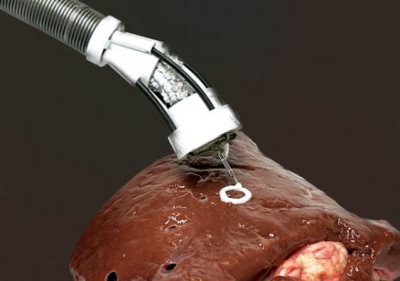Sydney– Australian researchers have developed a miniature and flexible soft robotic arm which could be used to 3D print biomaterial directly onto organs inside a person’s body.
3D bioprinting is a process whereby biomedical parts are fabricated from so-called bioink to construct natural tissue-like structures.
Bioprinting is predominantly used for research purposes such as tissue engineering and in the development of new drugs — and normally requires the use of large 3D printing machines to produce cellular structures outside the living body.
The tiny flexible 3D bioprinter, developed by researchers at the University of New South Wales in Sydney, has the ability to be inserted into the body just like an endoscope and directly deliver multilayered biomaterials onto the surface of internal organs and tissues.
The proof-of-concept device, known as F3DB, features a highly manoeuvrable swivel head that “prints” the bioink, attached to the end of a long and flexible snake-like robotic arm, all of which can be controlled externally.
According to the researchers, this could be especially important in surgery to remove certain cancers, especially colorectal cancer, via a process known as endoscopic submucosal dissection (ESD).
Within five to seven years, the technology could be used by medical professionals to access hard-to-reach areas inside the body via small skin incisions or natural orifices, said the researchers in a paper published in the journal Advanced Science.
Dr Thanh Nho Do and his team have tested their device inside an artificial colon, as well as 3D printing a variety of materials with different shapes on the surface of a pig’s kidney.
“Existing 3D bioprinting techniques require biomaterials to be made outside the body and implanting that into a person would usually require large open-field open surgery which increases infection risks,” said Dr Do, Senior Lecturer at UNSW’s Graduate School of Biomedical Engineering (GSBmE).
“Our flexible 3D bioprinter means biomaterials can be directly delivered into the target tissue or organs with a minimally invasive approach.
“This system offers the potential for the precise reconstruction of three-dimensional wounds inside the body, such as gastric wall injuries or damage and disease inside the colon,” Do said.
Further, experiments on living cells showed that the cells were not affected by the process, with the majority of the cells observed to be alive post-printing.
The cells then continued to grow for the next seven days, with four times as many cells observed one week after printing.
The researchers also plan to implement additional features, such as an integrated camera and real-time scanning system which would reconstruct the 3D tomography of the moving tissue inside the body. (IANS)
















